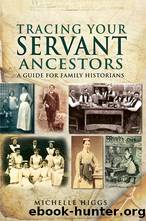Tracing Your Servant Ancestors by Michelle Higgs

Author:Michelle Higgs
Language: eng
Format: epub
Publisher: Pen & Sword Books
Published: 2012-08-19T00:00:00+00:00
Postcard of a group of servants with their pet dog, inscribed âBest love, from yours ever Molly xxxx Just a friendly group of us all, my best Pall [sic] beside meâ, circa 1905. Authorâs collection
Clothing
For a female servant, print dresses for morning work and black dresses for afternoon wear were the unofficial uniform, teamed with white caps and plain white or striped aprons. If she worked in the kitchen, the same dress was worn for the morning and afternoon. However, finding the money to pay for such clothing to start a job in service could be extremely difficult, and might mean a burden for her parents or taking a temporary job to save up for them.
Margaret Thomas was one of five children and her father died when she was 4. At the age of 14, she started looking after a baby and doing light jobs, then took a place cleaning knives and boots. In The Day Before Yesterday, she recalled: âEventually I saved enough and got my uniform: print dresses, morning aprons, black dress, afternoon aprons, stiff collars, and cuffs, all packed into a tin trunk, and set off to my first real job. I was just fifteen.â
In Below Stairs, Margaret Powell remembered how in the 1920s her mother had to borrow £2 to pay for the uniform her daughter needed for her first place as kitchen-maid at a large house in Hove, Sussex. She required âthree print dresses, blue or green; four white aprons with bibs, and four caps; stockings, and black strapped shoesâ. As Margaret recalled, âApart from the uniform my own clothes were very few indeed. I was dressed up in a blouse and skirt and a coat that had belonged to my grandmother.â
Being given a dress length was a standard Christmas present for female servants, but it was usually for work, not out of hours and therefore not necessarily a pattern they would have chosen for themselves. In any case, unless they were skilled in dressmaking, they still had to find the money to have the dress made up for them. Even if they could make their own clothes, there was very little free time in which to do it. Clothing might also be given when a master or mistress died and the family went into mourning.
The wearing of caps and bonnets, and even hairstyles, was very strictly regulated, giving rise to much disagreement between employer and servant. Female servants were expected to dress modestly but not to wear clothing above their station. As Anne Boulton advised her housemaid at Thornhill in the 1820s: âLet your dress be always neat and clean, but never fineâ. (MS 3782/14/83/21, Birmingham Archives and Heritage Service)
Employers could, and did, regulate the amount of decoration and the material their servantsâ clothes were made from, and this extended to their off-duty hours. In the 1880s, a large number of newspaper advertisements for servantsâ positions started to specify âNo fringesâ. This was a reference to a particular style of hair, the objection presumably
Download
This site does not store any files on its server. We only index and link to content provided by other sites. Please contact the content providers to delete copyright contents if any and email us, we'll remove relevant links or contents immediately.
Twilight of the Idols With the Antichrist and Ecce Homo by Friedrich Nietzsche(17707)
CHERUB: The Recruit by Robert Muchamore(1828)
CHERUB: The Fall by Robert Muchamore(1712)
CHERUB: Man vs Beast by Robert Muchamore(1611)
I Capture the Castle by Dodie Smith(1574)
The Edge of the Abyss (Sequel to The Abyss Surrounds Us)(1468)
Black Genesis by Robert Bauval(1319)
A Brief History of Everyone Who Ever Lived by Adam Rutherford(1249)
all by Unknown Author(1243)
Where Do I Start? by Chase Taylor Hackett(1060)
2016 Baby Names Almanac(978)
Painfully Rich by John Pearson(958)
Genetics by Adam Rutherford(921)
How to Argue With a Racist by Adam Rutherford(881)
2011 Baby Names Almanac(842)
Black Hawk Down by Mark Bowden(829)
It's All Relative by A. J. Jacobs(798)
My European Family by Karin Bojs(786)
Spook Street (Slough House) by Mick Herron(781)
